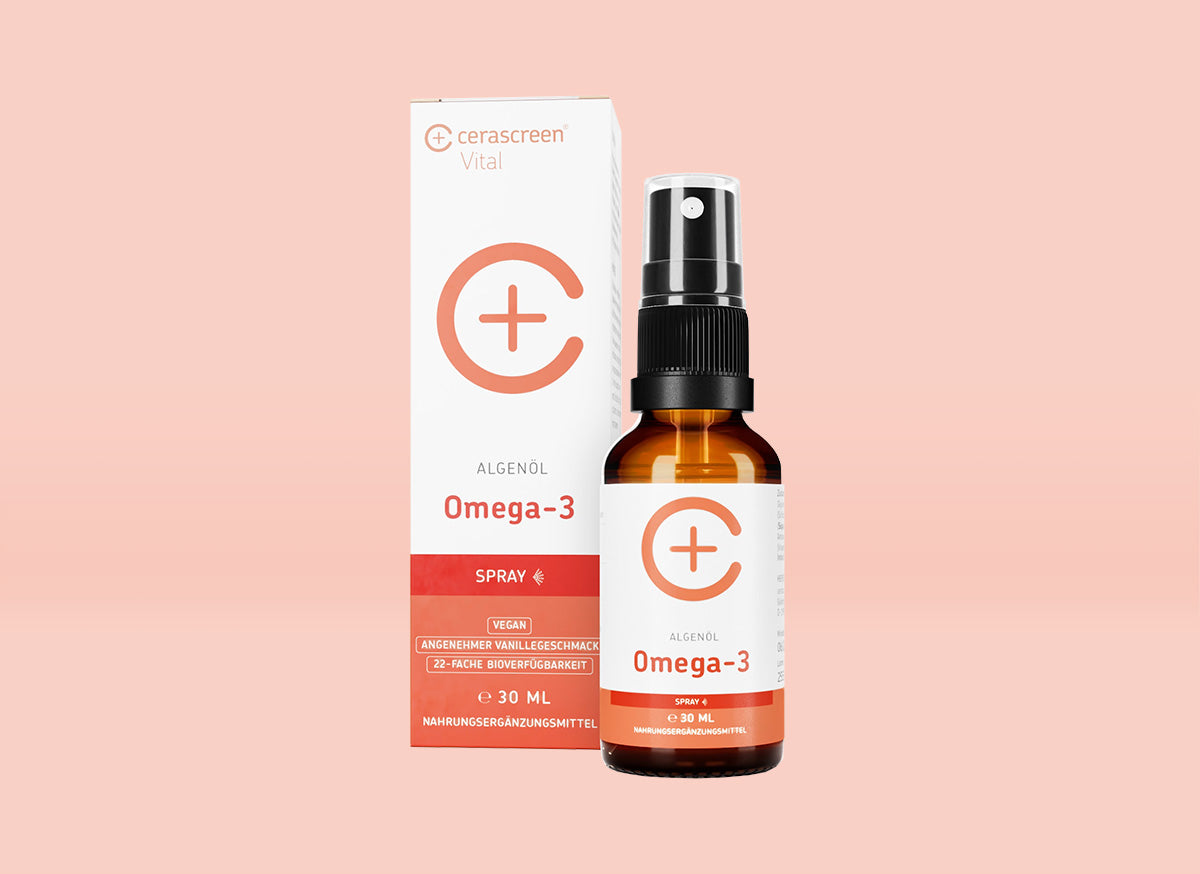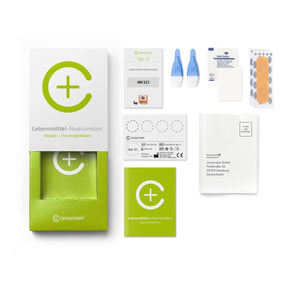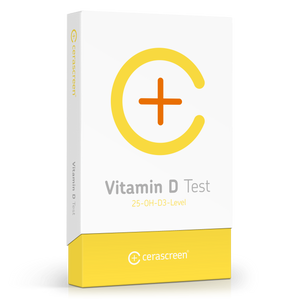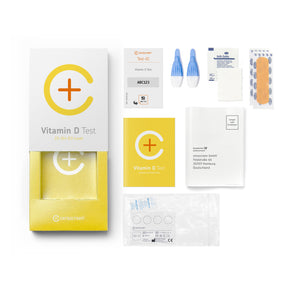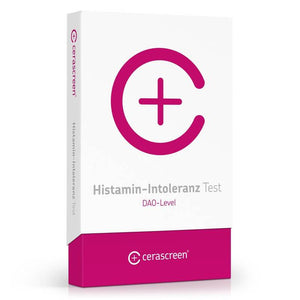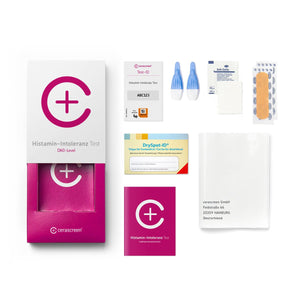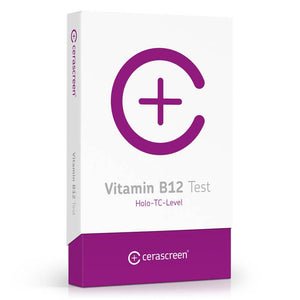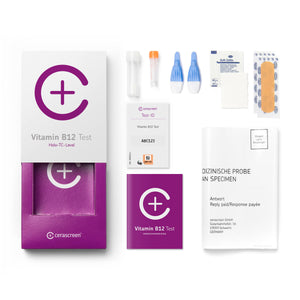product_id = 8369686872329variant_id = 44788789772553template_name =

Lebensmittelallergie Test
IgE-Analyse von 38 Lebensmitteln
Über den Test
Sind Sie allergisch auf Lebensmittel? Diese Frage ist nicht immer leicht zu beantworten. Klar: Starke Allergiker reagieren oft seit frühester Kindheit mit eindeutigen Symptome auf Erdnuss, Soja, Fisch und Co. Doch bei einigen Menschen entwickeln sich Allergien erst im Lauf des Lebens und die Anzeichen sind weniger klar. Im Alltag kann das trotzdem unangenehm und einschränkend werden, mit Beschwerden wie Hautausschlägen, Magen-Darm-Problemen und Halsschmerzen.
Der cerascreen®Lebensmittelallergie Test hilft Ihnen, solchen versteckten Allergien nachzugehen. Mit dem Selbsttest für Zuhause bestimmen Sie die Konzentration spezifischer IgE-Antikörper in Ihrem Blut. Diese Antikörper-Analyse liefert erste Hinweise auf eine mögliche Lebensmittelallergie.Für eine endgültige Allergie-Diagnose besprechen Sie die Ergebnisse mit Ihrer Ärztin oder Ihrem Arzt.
Auf welche Lebensmittel wird getestet?
Der cerascreen Lebensmittelallergie Test untersucht die Konzentration spezifischer IgE-Antikörper zu 38 verschiedenen Lebensmitteln. Damit deckt der Test die Nahrungsmittel ab, die für einen Großteil der Lebensmittelallergien in Europa verantwortlich sind.
Spezifische IgE-Antikörper für folgende Nahrungsmittel werden untersucht:
| Getestete Lebensmittel |
|---|
|
Fleisch Huhn, Lamm, Rind |
|
Fisch & Meeresfrüchte Dorsch, Garnele, Lachs, Thunfisch |
|
Milchprodukte und Ei Eiklar, Kuhmilch |
|
Getreide und Kartoffeln Gerste, Hafer, Kartoffeln, Mais, Reis, Weizen |
|
Gemüse Ingwer, Karotte, Knoblauch, Sellerie, Tomate, Zwiebel |
|
Saaten Senf, Sesam |
|
Leguminosen Bohne (grün), Erdnuss, Soja |
|
Nüsse Cashewnuss, Haselnuss, Mandel, Walnuss |
|
Obst Ananas, Apfel, Banane, Erdbeere, Kiwi, Mango. Orange, Pfirsich |
Lebensmittelallergie Test
- einfach zuhause Blutprobe entnehmen
- professionelle Laboranalyse nach wenigen Tagen
- medizinisch etablierte Messung von IgE-Antikörpern
- inkl. 15-minütiger Telefonberatung mit Ernährungsfachkraft
- Ergebnis innerhalb von 5 Werktagen nach Probeneingang im Labor
Bluttests vs. Haartests
Immer wieder werden auch Haartests angeboten, mit denen teilweise hunderte von Allergien und Intoleranzen gleichzeitig bestimmt werden sollen. Diese Tests eignen sich aber nicht dazu, Reaktionen auf Lebensmittel festzustellen. Antikörper lassen sich in Haaren nicht nachweisen. Stattdessen basieren viele Haartests auf Methoden wie der "Bioresonanz", deren Wirksamkeit in der Wissenschaft nicht erwiesen ist.
Bluttests wiederum sind in der Medizin schon seit Jahrzehnten ein etabliertes Standardverfahren, um Allergien festzustellen. Die IgE-Analyse ist wissenschaftlich untermauert und gilt als der beste labortechnische Hinweis auf eine mögliche Allergie.
Quelle: Hoffmann, Hans Jürgen, Darsow, Ulf, Hofmaier, Stephanie, Kleine-Tebbe, Jörg, Matricardi, Paolo M., Wedi, Bettina and Eberlein, Bernadette. "Molekulare und Zelluläre Möglichkeiten in der Allergiediagnostik" LaboratoriumsMedizin, vol. 41, no. 4, 2017, pp. 159-166
Häufige Symptome von Lebensmittelallergien
Zu den typischen Symptomen von Lebensmittelallergien gehören:
- Magen-Darm-Beschwerden wie Durchfall, Bauchweh und Übelkeit
- Hautausschläge
- Atemwegsbeschwerden wie Schnupfen, Husten, Keuchen und Kurzatmigkeit
- Kribbeln, Rötungen und Schwellungen an Mund, Zunge und Rachen
Außerdem kann es zu einem anaphylaktischen Schock kommen, einer schweren allergischen Reaktion, die sich oft durch Schwindel ankündigt. Dieser Allergieschock ist ein medizinischer Notfall, er kann zu Bewusstlosigkeit führen und sogar lebensgefährlich sein.
Magen-Darm-Beschwerden: Wenn unverträgliche Lebensmittel in den Magen und Darm gelangen, kann es zu Beschwerden wie Übelkeit, Bauchschmerzen, Erbrechen und Durchfall kommen. Diese Magen-Darm-Beschwerden gelten als typische Symptome einer Lebensmittelallergie.
Hautausschläge: Tatsächlich zeigen sich Lebensmittelallergien auch sehr häufig auf der Haut. Übliche Beschwerden sind dann Rötungen, Quaddeln, Nesselsucht, Kribbeln und Juckreiz.
Atemwegsbeschwerden: Eine laufende Nase oder ein rauer Hals können durch Lebensmittelallergien verursacht werden. Weitere mögliche Symptome sind Husten, Niesen, Keuchen und Kurzatmigkeit.
Sie bekommen von uns nicht einfach eine Tabelle mit Werten aus dem Labor!

Was Sie im Ergebnisbericht erwartet:
Ihr Testergebnis:
Die genauen Messwerte, verständlich erklärt. Sie erhalten eine Tabelle mit den getesteten Lebensmitteln. Darin erfahren Sie, wie stark Sie jeweils auf die Allergene reagieren, auf einer Skala von 0 bis 6.
Die nächsten Schritt:
Was die gemessenen Antikörper-Werte bedeuten und wie Sie unverträglichen Lebensmitteln aus dem Weg gehen. Im Bericht finden Sie zum Beispiel auch Tipps zu weiteren Diagnosemethoden.
Gesundheitswissen:
Der Bericht vermittelt Ihnen alle nötigen Hintergrundinfos und Fakten. Sie erhalten zum Beispiel spannende Fakten und Links zu relevanten Artikeln, auch zum Thema Kreuzallergien und Unverträglichkeiten
Fragen zum Lebensmittelallergie Test
Warum auf Lebensmittelallergie testen?
Einige Menschen leiden unter Lebensmittelallergien – oft ohne es wissen. In einigen Fällen sind die Beschwerden zwar lästig und auf Dauer ungesund, aber auch subtil und nur schwer bestimmten Mahlzeiten zuzuordnen. Gerade dann kann es sinnvoll sein, mit einem Test eine erste Orientierung zu erhalten, was Sie möglicherweise nicht vertragen könnten.
Theoretisch könnten Sie dabei gegen alle möglichen Lebensmittel allergisch sein. In der Praxis sind es aber immer wieder die üblichen Verdächtigen, die für einen Großteil der Allergien verantwortlich sind. Diese häufigen Allergie-Auslöser unter den Nahrungsmitteln – und noch einige mehr – werden im cerascreen® Lebensmittelallergie Test berücksichtigt.
Schaffen Sie es mit Hilfe des Tests, eine bislang unerkannte Lebensmittelallergie herauszufinden, ist der Weg klar: Es gilt, das Nahrungsmittel aus Ihrem Speiseplan zu streichen. Das ist bei manchen Speisen schwieriger als bei anderen. So oder so können Sie dadurch aber die Verursacher Ihrer Beschwerden künftig umgehen.
Wie funktioniert der Allergietest?
Der Test läuft ähnlich ab wie ein Allergietest auf Lebensmittel beim Arzt – es wird aber viel weniger Blut benötigt. Für den Lebensmittelallergie Test entnehmen Sie sich mit einer Lanzette wenige Tropfen Blut aus Ihrer Fingerspitze. Alles, was Sie für die Entnahme brauchen, ist im Testkit enthalten.
Die Probe schicken Sie anschließend an ein Diagnostik-Fachlabor geschickt. Das Labor analysiert, wie hoch die Anzahl bestimmter IgE-Antikörper in Ihrem Blut ist. Diese Antikörper zeigen jeweils an, ob eine Sensibilisierung gegen eines von 38 verschiedenen Lebensmitteln vorliegt. Nach der Auswertung bekommen Sie eine Benachrichtigung und können über den Online-Kundenbereich oder die mein cerascreen® App auf Ihren persönlichen Ergebnisbericht zugreifen.
Wichtig: Am aussagekräftigsten ist der Test, wenn Sie in den Wochen vor der Probeentnahme Kontakt mit dem Allergen hatten Meiden Sie vor dem Test also nicht die Allergene, die wir hier analysieren – es sei denn, Sie haben bereits eine bekannte starke Allergie gegen ein bestimmtes Allergen.
Was sagt mir das Ergebnis?
Der Ergebnisbericht zum Lebensmittelallergie Test zeigt auf, für welche Lebensmittel sich größere Mengen IgE-Antikörper im Blut befinden. Anhand einer übersichtlichen Tabellen erkennen Sie, wie stark Sie jeweils auf 38 unterschiedliche Lebensmittel und Lebensmittelgruppen sensibilisiert sind.
An dieser Sensibilisierung lässt sich ablesen, wie hoch das Potential Ihrer Abwehrkräfte ist, mit allergischen Reaktionen auf ein Lebensmittel zu reagieren. Sie stellt also einen ersten Hinweis auf eine mögliche Lebensmittelallergie dar.
Eine gesicherte Allergie-Diagnose kann der Test Ihnen nicht geben. Die Diagnose dürfen nur Ärzte stellen, die einen Allergietest auf Lebensmittel mit einer Anamnese verbinden, Sie also zu Ihren Symptomen und Ihrem Gesundheitszustand befragen. Sie können die Ergebnisse aber als ersten Anhaltspunkt nutzen, um ein weiteres Vorgehen mit Ihrem Arzt zu besprechen, der dann gegebenenfalls keine Hauttests oder Blutproben mehr durchführen muss.
Welche Empfehlungen erhalte ich?
Sie erhalten Empfehlungen dazu, wie Sie mit dem Testergebnis umgehen können. Wichtig ist, dass Sie dabei in Betracht ziehen, ob Sie nach dem Verzehr bestimmter Lebensmittel Beschwerden haben. Es kommt vor, dass Menschen eine erhöhte Zahl von IgE-Antikörpern gegen ein Lebensmittel im Blut haben, aber trotzdem keine Symptome zeigen.Auch für diesen Fall erhalten Sie im Ergebnisbericht Handlungsempfehlungen.
Außerdem erhalten Sie Empfehlungen, wie Sie mit festgestellten Allergien umgehen und wie Sie Ihre Ernährung trotz Lebensmittelallergie gesund und ausgewogen gestalten. Wir geben konkrete Tipps, mit denen Sie Ihre Verdauung und Ihre Darmgesundheit unterstützen können.
Wie häufig sind Lebensmittelallergien?
In Deutschland haben laut Schätzungen der Deutschen Gesellschaft für Ernährung drei bis vier Prozent der Erwachsenen eine Lebensmittelallergie.
Bei Kindern sind Allergien gegen Lebensmittel etwas häufiger, sie legen sich dann in vielen Fällen bis zum Jugend- oder Erwachsenenalter von selbst wieder.
Welche Art von Allergie wird getestet?
Es gibt verschiedene Arten von Allergien. Bei weitem die häufigste Art ist die Typ-1-Allergie, auch Allergie des Sofort-Typs genannt. Lebensmittelallergie fallen in aller Regel in diese Kategorie.
Diese Typ-1-Allergien gehen mit erhöhten Konzentrationen von IgE-Antikörpern einher. Genau diese Konzentrationen untersucht der cerascreen® Lebensmittelallergie Test, für 38 verschiedene Lebensmittel. Damit erhalten Sie erste Hinweise auf eine mögliche Allergie vom Sofort-Typ.
Was sind IgE-Antikörper?
Antikörper gehören zu den Abwehrmechanismen Ihres Immunsystems. Es handelt sich um bestimmte Proteine (Eiweiße). Der Körper setzt Sie vor allem dazu ein, Krankheitserreger wie Viren und Bakterien auszuschalten. Es gibt verschiedene Klassen von Antikörpern mit jeweils unterschiedlichen Aufgaben. Die Immunglobuline E (IgE) sind auf die Abwehr von Parasiten, zum Beispiel von Würmern, spezialisiert.
Wenn die Abwehrzellen Ihres Körpers Krankheitserreger oder Parasiten erkennen, dann geben Sie diese Information an Plasmazellen weiter, eine Klasse von weißen Blutzellen. Diese stellen dann spezifische Antikörper her. "Spezifisch" bedeutet, dass diese Antikörper nur dazu da sind, Reaktionen gegen einen ganz bestimmten Krankheitserreger einzuleiten.
Wie hängen IgE und Allergie zusammen?
Wenn Sie unter einer Allergie leiden, hat Ihr Körper in der Vergangenheit einen harmlosen Stoff mit einem bedrohlichen Krankheitserreger verwechselt. Stoffe, die dafür in Frage kommen, sind Proteine (Eiweiße), die unter anderem in Lebensmitteln, Pollen, Tierhaaren, Hausstaubmilben und Medikamenten vorkommen. Man bezeichnet diese möglichen Allergie-Auslöser als Allergene.
Ihr Immunsystem hat nach dieser Verwechslung bestimmte IgE-Antikörper gegen das Allergen hergestellt. Treffen dieselben Stoffe nun nochmal auf den Körper, schlagen Ihre Abwehrkräfte deswegen Alarm. Sie leiten Abwehrreaktionen ein: Der Botenstoff Histamin wird ausgeschüttet, es kommt zu Entzündungen und damit zu den typischen Beschwerden einer Allergie.
Die IgE-Antikörper können das ganze Leben lang in Ihrem Körper bleiben. In einigen Fällen verschwinden die Allergien aber auch wieder. Bei Lebensmittelallergien beginnt die Sensibilisierung meist schon im Kindesalter. Als Jugendliche verlieren dann viele ihre Allergien gegen Kuhmilch, Eier, Weizen und Soja. Allergien gegen Nüsse, Fische und Schalentiere wiederum bleiben in den meisten Fällen für den Rest des Lebens bestehen.
Welche Symptome gibt es?
Die Lebensmittelallergie ist eine Allergie des Sofort-Typs. Die Beschwerden treten meistens sofort oder nur wenige Minuten nach dem Essen auf.
Typische Symptome einer Lebensmittelallergie sind:
- Ausschläge und Rötungen auf der Haut
- Magen-Darm-Beschwerden wie Durchfall, Erbrechen und Bauchschmerzen
- Gaumenjucken und pelzige Zunge
- Atembeschwerden bis hin zum allergischen Asthma
Was ist der anaphylaktische Schock?
Vor allem Nüsse, Soja und tierische Lebensmittel wie Milch, Ei und Schalentiere können auch einen gefährlichen allergischen Schock (anaphylaktischen Schock) auslösen. Dabei fällt der Blutdruck plötzlich ab. Das kann zu Ohnmacht und in seltenen Fällen sogar zum Tod führen.
Wenn Sie schon einmal einen anaphylaktischen Schock hatten oder bei Ihnen ein Risiko dafür festgestellt wurde, verordnen Ärzte Ihnen ein Anaphylaxie-Notfallset. Darin sind Medikamente enthalten, mit denen Sie dieser heftigen allergischen Reaktion entgegenwirken können. Vor allem: ein Adrenalin-Pen, mit dem Sie sich Adrenalin in den Oberschenkel spritzen können, was in der Regel den Abfall des Blutdrucks verhindert.
Welche Lebensmittel lösen Allergien aus?
Mehr als 170 Lebensmittel können für Allergien verantwortlich sein. Eine deutlich kleinere Zahl von Nahrungsmitteln ist aber mit Abstand am häufigsten verantwortlich. Zu ihnen zählen:
- Kuhmilch und Eier
- Hülsenfrüchte (vor allem Erdnüsse und Soja)
- Schalenfrüchte (vor allem Nüsse)
- Weizen
- Fisch und Schalentiere
Etwas seltener sind Allergien gegen verschiedene Sorten Obst, Gemüse und Gewürze sowie gegen Fleisch.
Was tue ich bei Lebensmittelallergie?
Es gibt keine Therapie, um eine Allergie gegen Lebensmittel zu heilen. In manchen Fällen legen sich Allergien mit der Zeit von alleine wieder. Mediziner kennen noch keinen Weg, um das effektiv zu beeinflussen.
Als einzige langfristig wirksame Maßnahme bleibt deshalb, das Nahrungsmittel zu meiden, das Sie nicht vertragen. Das kann bedeuten, dass Sie etwas Zeit darauf verwenden müssen, Zutatenlisten auf Verpackungen zu studieren. Denn viele Produkte enthalten Allergene, die Sie so gar nicht in Ihnen erwarten würden. Gerade Soja, Ei, Milch und Weizen stecken in zahlreichen Fertigprodukten und verarbeiteten Lebensmitteln.
Zum Glück müssen Hersteller die 14 wichtigsten Allergene auf Ihren Produkten kennzeichnen und hervorheben. Und auch Restaurants und Bäckereien müssen Ihnen darüber Auskunft geben.
Gibt es Medikamente gegen Allergie?
Medikamente helfen bei Lebensmittelallergien nur, um die Symptome zu unterdrücken. Mit Antihistaminika können Sie allergische Beschwerden vorübergehend lindern. Diese “Allergietabletten” sind dieselben Medikamente, die auch bei Heuschnupfen zum Einsatz kommen. Sie sind aber nicht für eine langfristigen Einnahme geeignet.
Menschen, die besonders heftige allergische Reaktionen haben, tragen oft ein Anaphylaxie-Notfallset mit einem Adrenalin-Injektor mit sich. Das Set kann für Sie lebensrettend sein, wenn sie einen anaphylaktischen Schock erleiden.
Warum dürfen Kinder unter 18 Jahren den Test nicht durchführen?
Unsere Tests sind nicht für minderjährige Kinder und Jugendliche unter 18 Jahren geeignet. Unter 18-Jährige können die Tests nicht online aktivieren und somit auch kein Testergebnis erhalten. Wir bitten Sie darum, die Tests auch nicht an Ihren Kindern durchzuführen.
Kinder und Jugendliche brauchen eine viel engere Betreuung und Beratung, was medizinische Tests und deren Interpretation angeht. Die Testdurchführung mit Lanzetten und Chemikalien ist nicht ohne Risiko und müsste von Erziehungsberechtigten eng betreut werden. Dazu kommt, dass die Referenzwerte, die wir für die Messwerte angegeben, immer auf Daten von Erwachsenen beruhen. Bei Kindern wäre das Risiko sehr hoch, dass die Ergebnisse falsch interpretiert werden.
Wir wollen unserer Verantwortung als Anbieter von Medizinprodukten nachkommen und sichergehen, dass Kinder und Jugendliche nicht durch für sie schwer interpretierbare Messergebnisse verunsichert werden. Da wir nicht kontrollieren können, ob die Erziehungsberechtigten der Minderjährigen tatsächlich der Testdurchführung zustimmen und sie beaufsichtigen, schließen wir die Tests für unter 18-Jährige ganz aus.
Wenn Sie unter 18 sind und einen Test gekauft haben, wenden Sie sich bitte an unseren Kundensupport.
